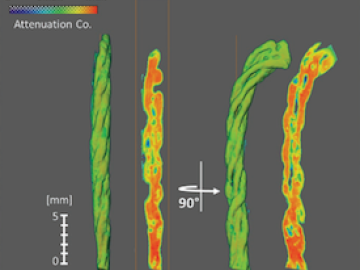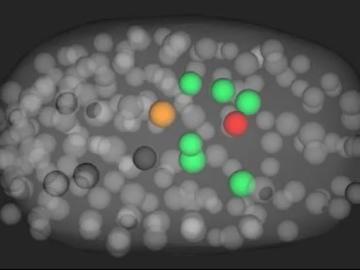
Filter News
Area of Research
- Advanced Manufacturing (4)
- Biology and Environment (5)
- Computational Biology (1)
- Computational Engineering (1)
- Computer Science (4)
- Energy Science (35)
- Fusion and Fission (2)
- Fusion Energy (7)
- Isotopes (1)
- Materials (26)
- Materials for Computing (7)
- National Security (1)
- Neutron Science (24)
- Nuclear Science and Technology (12)
- Nuclear Systems Modeling, Simulation and Validation (1)
- Supercomputing (8)
- Transportation Systems (2)
News Type
News Topics
- (-) Artificial Intelligence (16)
- (-) Biomedical (11)
- (-) Fusion (9)
- (-) Machine Learning (14)
- (-) Materials Science (34)
- (-) Molten Salt (5)
- (-) Neutron Science (27)
- (-) Nuclear Energy (19)
- (-) Partnerships (2)
- (-) Security (1)
- (-) Transportation (36)
- 3-D Printing/Advanced Manufacturing (34)
- Advanced Reactors (13)
- Big Data (17)
- Bioenergy (17)
- Biology (21)
- Biotechnology (4)
- Buildings (21)
- Chemical Sciences (13)
- Clean Water (14)
- Composites (11)
- Computer Science (42)
- Coronavirus (11)
- Critical Materials (12)
- Cybersecurity (3)
- Emergency (1)
- Energy Storage (32)
- Environment (48)
- Exascale Computing (1)
- Fossil Energy (1)
- Frontier (1)
- Grid (22)
- High-Performance Computing (12)
- Hydropower (6)
- Irradiation (2)
- Isotopes (5)
- ITER (3)
- Materials (36)
- Mathematics (3)
- Mercury (3)
- Microscopy (11)
- Nanotechnology (12)
- National Security (3)
- Physics (4)
- Polymers (10)
- Quantum Computing (5)
- Quantum Science (11)
- Simulation (9)
- Space Exploration (10)
- Statistics (1)
- Summit (8)
Media Contacts

Textile engineering researchers from North Carolina State University used neutrons at Oak Ridge National Laboratory to identify a special wicking mechanism in a type of cotton yarn that allows the fibers to control the flow of liquid across certain strands.

To study how space radiation affects materials for spacecraft and satellites, Oak Ridge National Laboratory scientists sent samples to the International Space Station. The results will inform design of radiation-resistant magnetic and electronic systems.

Scientists have developed a novel approach to computationally infer previously undetected behaviors within complex biological environments by analyzing live, time-lapsed images that show the positioning of embryonic cells in C. elegans, or roundworms. Their published methods could be used to reveal hidden biological activity.

A discovery by Oak Ridge National Laboratory researchers may aid the design of materials that better manage heat.


Oak Ridge National Laboratory researchers developed and demonstrated algorithm-based controls for a hybrid electric bus that yielded up to 30% energy savings compared with existing controls.

Staff at Oak Ridge National Laboratory organized transport for a powerful component that is critical to the world’s largest experiment, the international ITER project.

Oak Ridge National Laboratory researchers have developed a new catalyst for converting ethanol into C3+ olefins – the chemical

Equipment and expertise from Oak Ridge National Laboratory will allow scientists studying fusion energy and technologies to acquire crucial data during landmark fusion experiments in Europe.

Researchers at Oak Ridge National Laboratory have developed a nationwide modeling tool to help infrastructure planners decide where and when to locate electric vehicle charging stations along interstate highways. The goal is to encourage the adoption of EVs for cross-country travel.


